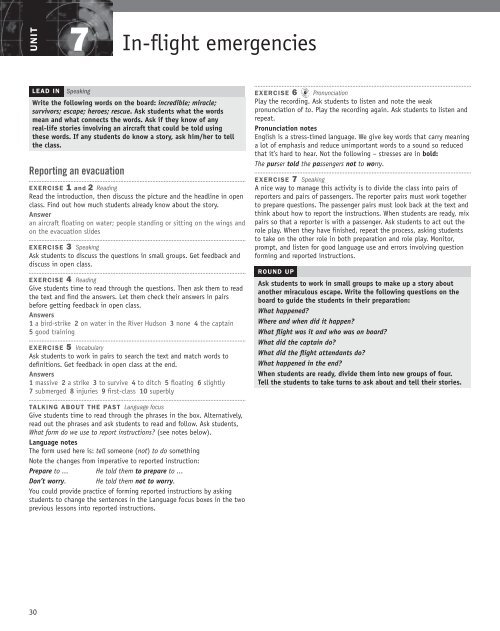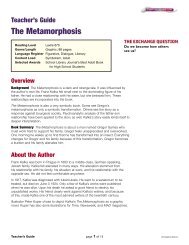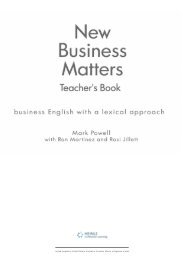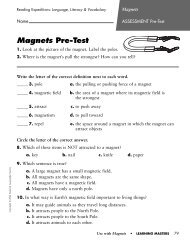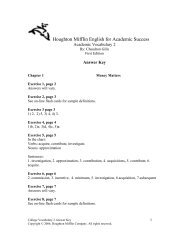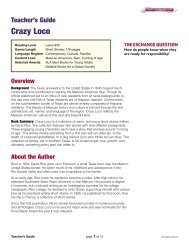English for Cabin Crew Trainer's Guide - Heinle
English for Cabin Crew Trainer's Guide - Heinle
English for Cabin Crew Trainer's Guide - Heinle
Create successful ePaper yourself
Turn your PDF publications into a flip-book with our unique Google optimized e-Paper software.
UNIT<br />
7 In-fl ight emergencies<br />
LEAD IN Speaking<br />
Write the following words on the board: incredible; miracle;<br />
survivors; escape; heroes; rescue. Ask students what the words<br />
mean and what connects the words. Ask if they know of any<br />
real-life stories involving an aircraft that could be told using<br />
these words. If any students do know a story, ask him/her to tell<br />
the class.<br />
Reporting an evacuation<br />
EXERCISE 1 and 2 Reading<br />
Read the introduction, then discuss the picture and the headline in open<br />
class. Find out how much students already know about the story.<br />
Answer<br />
an aircraft fl oating on water; people standing or sitting on the wings and<br />
on the evacuation slides<br />
EXERCISE 3 Speaking<br />
Ask students to discuss the questions in small groups. Get feedback and<br />
discuss in open class.<br />
EXERCISE 4 Reading<br />
Give students time to read through the questions. Then ask them to read<br />
the text and fi nd the answers. Let them check their answers in pairs<br />
be<strong>for</strong>e getting feedback in open class.<br />
Answers<br />
1 a bird-strike 2 on water in the River Hudson 3 none 4 the captain<br />
5 good training<br />
EXERCISE 5 Vocabulary<br />
Ask students to work in pairs to search the text and match words to<br />
defi nitions. Get feedback in open class at the end.<br />
Answers<br />
1 massive 2 a strike 3 to survive 4 to ditch 5 fl oating 6 slightly<br />
7 submerged 8 injuries 9 fi rst-class 10 superbly<br />
TALKING ABOUT THE PAST Language focus<br />
Give students time to read through the phrases in the box. Alternatively,<br />
read out the phrases and ask students to read and follow. Ask students,<br />
What <strong>for</strong>m do we use to report instructions? (see notes below).<br />
Language notes<br />
The <strong>for</strong>m used here is: tell someone (not) to do something<br />
Note the changes from imperative to reported instruction:<br />
Prepare to ... He told them to prepare to ...<br />
Don’t worry. He told them not to worry.<br />
You could provide practice of <strong>for</strong>ming reported instructions by asking<br />
students to change the sentences in the Language focus boxes in the two<br />
previous lessons into reported instructions.<br />
30<br />
EXERCISE 6 Pronunciation<br />
Play the recording. Ask students to listen and note the weak<br />
pronunciation of to. Play the recording again. Ask students to listen and<br />
repeat.<br />
Pronunciation notes<br />
<strong>English</strong> is a stress-timed language. We give key words that carry meaning<br />
a lot of emphasis and reduce unimportant words to a sound so reduced<br />
that it’s hard to hear. Not the following – stresses are in bold:<br />
The purser told the passengers not to worry.<br />
EXERCISE 7 Speaking<br />
A nice way to manage this activity is to divide the class into pairs of<br />
reporters and pairs of passengers. The reporter pairs must work together<br />
to prepare questions. The passenger pairs must look back at the text and<br />
think about how to report the instructions. When students are ready, mix<br />
pairs so that a reporter is with a passenger. Ask students to act out the<br />
role play. When they have fi nished, repeat the process, asking students<br />
to take on the other role in both preparation and role play. Monitor,<br />
prompt, and listen <strong>for</strong> good language use and errors involving question<br />
<strong>for</strong>ming and reported instructions.<br />
ROUND UP<br />
Ask students to work in small groups to make up a story about<br />
another miraculous escape. Write the following questions on the<br />
board to guide the students in their preparation:<br />
What happened?<br />
Where and when did it happen?<br />
What fl ight was it and who was on board?<br />
What did the captain do?<br />
What did the fl ight attendants do?<br />
What happened in the end?<br />
When students are ready, divide them into new groups of four.<br />
Tell the students to take turns to ask about and tell their stories.


